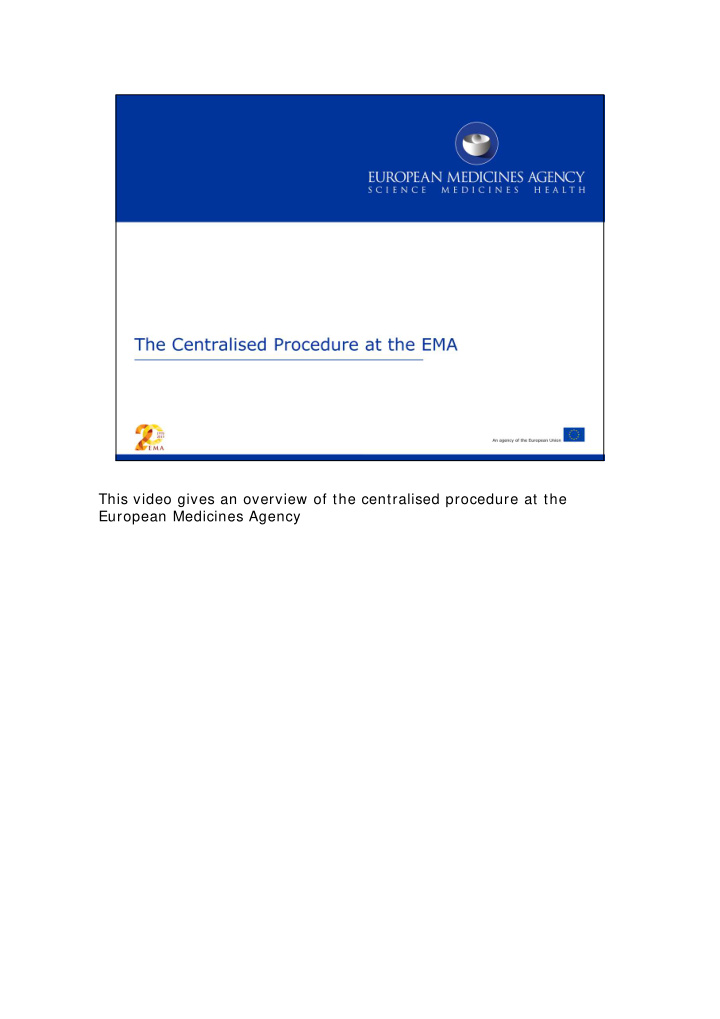



This video gives an overview of the centralised procedure at the European Medicines Agency
In Europe today, all medicines must have a marketing authorisation before they can be used by patients And there are 2 ways of obtaining that authorisation – the centralised procedure and the national marketing authorisation procedures Through the centralised procedure, the Agency gives an opinion and it results in a single marketing authorisation for the whole of the European Union. In the national procedures, individual member states authorise the medicines for use in their own territory. 1
The centralised procedure ensures a consistent approach to medicines regulation right across the European Union One application leads to one evaluation leading to one authorisation valid in the 28 Member States of the European Union as well as Iceland, Norway and Lichtenstein Importantly it also results in a single set of product information for healthcare professionals and patients in the all the European Union official languages.
Some medicines must come through the EMA to be approved and these include medicines for rare diseases (sometimes called orphan drugs), and for some disease areas like HIV/ AIDS, cancer, neurodegenerative disorders and diabetes. There are also some product types like those derived biotechnology and some gene therapy products that must also come to the Agency. The EMA has specific committees and working parties that specialise in evaluation of these products and disease areas
There are 7 of these scientific committees that evaluate medicines at the EMA – 6 of them are for human medicines and one, the CVMP is responsible for medicines for veterinary use. The Agency secretariat supports the work of these committees in a scientific and logistic capacity. Importantly four of these committees have members representing patients’ organisations and this provides important opportunities for patients to contribute their expertise and experience with their disease areas of interest
Here we see an overview of the medicines regulatory pathway and the different places where the committees interact In addition to the committees we can also bring in external experts to consult through the Scientific Advice Working Party or Scientific Advisory Groups; many of which involve patients
We are going to focus now on this particular step, the marketing authorisation application evaluation.
The assessment of an application for a new medicine can take up to 210 ‘active’ days. This active evaluation time is interrupted by at least one ‘clock-stop’ during which time the applicant prepares the answers to questions from the CHMP . The clock stop happens after day 120 and may also happen after day 180, when the CHMP has adopted a list of questions or outstanding issues to be addressed by the applicant company. The assessment leads to an opinion from the CHMP by day 210. Following a CHMP opinion the European Commission takes usually its decision, a legally binding authorisation, after 67 days. With prior agreement, these timelines can, under some circumstances, be accelerated and for more information about this please see our website.
In addition to a standard authorisation where comprehensive data has been provided to enable full evaluation of Quality, Safety and Efficacy sometimes… Conditional approval can be granted, when although comprehensive clinical data have not been supplied, and are unlikely to be able to be provided, the benefit risk balance is judged to be positive, because unmet needs will be fulfilled and the benefits of immediate availability outweigh risks due to the absence of the additional data. These approvals are valid for a renewable one year period. Some medicines are approved under Exceptional Circum stances and this is where the applicant is unable to provide data on the efficacy and safety of the medicine. This is usually where the indication so rare that the applicant cannot reasonably be expected to provide comprehensive evidence or it is contrary to medical ethics to collect such information.
Once approval by the European Commission has been granted, what happens then? The EMA monitors the safety of medicines for as long as they are on the market and if necessary takes regulatory actions to protect public health in the EU. You can hear more about this in our Pharmacovigilance video. You can find more information about specific medicines that have been authorised on the Agency’s website
The EMA publishes an European Public Assessment Report (more often known as an EPAR) for all medicines granted a marketing authorisation by the European Commission and you can find them under the Find Medicine tab on our website. The EPAR includes a short document written in the form of a question and answer document for the public that gives an overview of the process and all these documents are reviewed by patients to make sure they are understandable. And many of these documents are available in all the languages of the European Union. The EPAR summary and all package leaflets are available in all official languages of the European Union
For more information about the Centralised Procedure or any aspect of the work of the Agency, please visit our website: www.ema.europa.eu
Recommend
More recommend